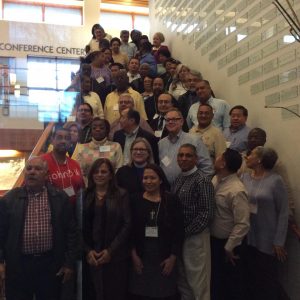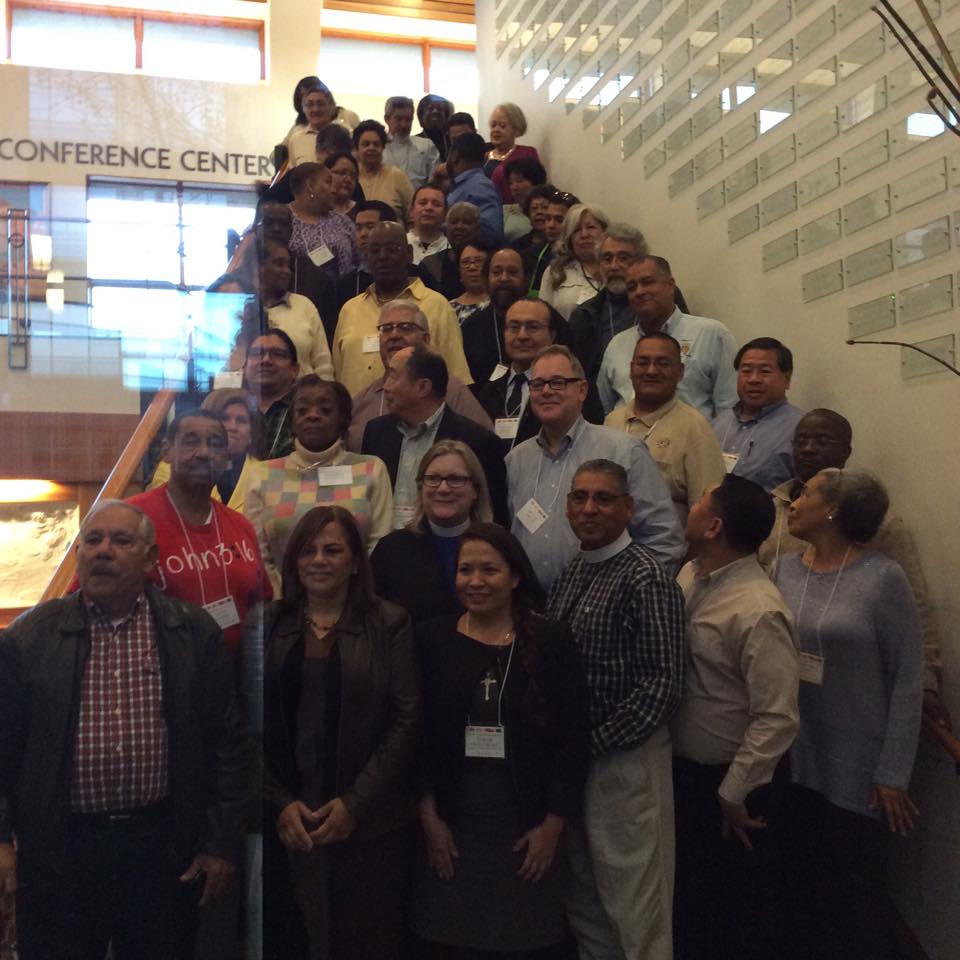
A couple of weeks ago, some small change, fifty years in the making, came to the Shenandoah Valley of Virginia. Congressman John Lewis, lion of the civil rights movement, received the Jonathan Daniels Humanitarian Award from the Virginia Military Institute.
Now some of you could probably recite the story of Jonathan Daniels in your sleep. But let me summarize it quickly: Jonathan Daniels is a martyr of the Civil Rights movement whose commemoration we celebrate in the Episcopal Church on August 14. He was a graduate of Virginia Military Institute—called VMI—and a seminarian at Episcopal Divinity School when he answered the call first to go to Selma, where he marched from Selma to Montgomery and then stayed to register voters, tutor children, and live among African American people in Alabama who had been disenfranchised, beaten down, and impoverished. On August 20, 1965, Daniels was killed by a deputy sheriff named Tom Coleman after he pushed 17-year-old Ruby Sales out of the way of Coleman’s gun. Coleman was acquitted by an all-white jury.
In his acceptance speech at VMI, Lewis, who was beaten by state troopers on Bloody Sunday in Selma, noted that Daniels was seen by many people in the South as an “outside agitator.” He said that Daniels “found a way to get in the way,” to get into “good trouble, necessary trouble.” He said that others who got into “good trouble, necessary trouble” were Dr. Martin Luther King Jr., Rosa Parks, and Lewis himself.
On the face of it, you may not think that civil rights hero John Lewis getting an award named for civil rights martyr Jonathan Daniels represents much change. But the award was given by a Southern military school that was for 130 years, until 1968, all white. When Jonathan Daniels attended VMI, it was a segregated institution. And until this year—until 2015—the physical award given to honorees was a replica of a statue called “Virginia Mourning Her Dead,” which commemorates students at the school who fought for the Confederacy. This year, Congressman John Lewis received a medal bearing the likeness of Jonathan Daniels.
So change is sometimes very slow, and sometimes very painful, and sometimes, to people looking in from the outside, what has to be overcome is difficult to believe, much less to understand. Maybe this sounds like another institution you know?
In the last fifty years, our beloved Episcopal Church has made a good deal of progress toward becoming more just, more inclusive, more like the kingdom of God. But you know that too often, our progress has been very slow and very painful, and sometimes what we have had to overcome has been unbelievable. Too often we have advocated only for justice in our own leadership structures and not enough for justice in the world around us. Too often, we find ourselves stuck in old dichotomies about race and class and gender. Too often we fall back on our unquestioned assumptions about one another. Too often those of us who benefit from white privilege allow it to blind us to systemic racism in our church and in our world.
You know that we still have a lot of work to do. Three months from now, we’ll be right back here in the midst of General Convention, and that will give us the opportunity to get some of this work done. At this General Convention, in the midst of the debate about the structure of the church, we’ll have the opportunity—I would argue that we’ll have the obligation—to ensure that our church is structured to do the work of justice in the church and the world. Put simply, we need a church that allows us—encourages us—to get into what Congressman Lewis called good trouble, necessary trouble.
This is the kind of trouble we get into when we stand on the side of children who flee across our southern border to escape violent lawlessness in Guatemala, Honduras, El Salvador and Nicaragua. It’s the kind of trouble we get into when we speak out against discrimination against lesbian, gay, bisexual and transgender people. It’s the kind of trouble we get into when we hold the church accountable for the disparity of resources among congregations and dioceses that has its roots in slavery, in segregation, in the genocide of Native Americans, in unjust immigration policy and anti-miscegenation laws aimed at Asian people. It’s the kind of trouble we get into when we stand up at microphones in the House of Deputies and advocate—sometimes agitate—for resolutions that we can take back home, take to our lawmakers, and take to Washington to show that the Episcopal Church stands for the dignity of every human being.
Now we all know that we live in a new economy and that as we discuss church structure, we’re going to have to change and to let go of some things. At some level, most of us know that the church many people once knew is coming to its end. For some, that is an occasion for grief. For some of us, it feels like liberation.
But what should we change? What is essential to our identity as Episcopalians and what is simply the way we have always done it?
Sometimes when I listen to discussions about restructuring, I hear a false choice. I hear the assertion that for the church to be organized effectively for mission, we have to get rid of much of our participatory governance.
“It’s too big, it’s too bloated, it’s too expensive, it’s too messy.” “If only we could concentrate authority in a CEO, or in a primate, we’d be nimble enough to be the church of the 21st century.”
By the way, in case anyone asks you, General Convention costs 1.1% of the churchwide budget.
These conversations can become pretty charged with emotion. I think that’s because when we talk about structure, we’re really talking about our identity. We’re talking about our vision of the Beloved Community, and whether restructuring could impoverish it or imperil it if we lose sight of the gifts of all orders of ministry. We are talking about who we are as the people of God if we are not the church we have been. We are talking about the fate of the governance structures through which we have progressed—sometimes haltingly, sometimes kicking and screaming—toward equality for people of color, for women, and for lesbian, gay, bisexual and transgender Christians. Without the shared leadership of bishops and deputies, we might not have achieved our prophetic stands on the death penalty, racism, gun control and poverty or been able to carry out as effectively our churchwide work toward justice and peace.
So when we talk about structure, we are getting clear about what is unnecessary and what is the inevitable messiness of our democracy—democracy that makes possible not just our ministries of social justice and advocacy, but also the very mission of the church. We are figuring out what rules we need to advance the cause of justice and equality. And we are figuring out what parts of our structure are unjust and can, to borrow a phrase from Bishop Antonio Ramos, no longer stand the judgment of the liberating Christ.
We’re having these conversations about structure at a time when the threat to leadership of people of color in the church’s governance structure is extreme. While in 2012, 48% of deputies were women, only 11% were women of color. Of those women, four were Latina, three were Asian women, six were indigenous, and 34 were black or African-American. The average age of the black female deputies in 2012 was 65, and the youngest of those deputies was 49. Without identifying and mentoring younger leaders, we are in danger of losing the gifts, perspectives and voices of black female deputies within the next decade.
So, we have a lot of work to do and a lot of trouble to get into, and we need a church structure that will help us do it, not a church structure that will limit even further the voices we most need to hear. I believe that you, as deputies of color, have a particular role to play in this debate about Episcopal Church’s structure. Especially in this time of great change, your stories, your perspectives, your passion for the Gospel work of advancing justice will keep us from losing ourselves in structural debate and help us remember that the purpose of church structure is to bring us closer to realizing God’s dream of the Beloved Community.
In accepting the Jonathan Daniels Humanitarian Award, Congressman Lewis said, “For someone who grew up preaching to chickens, I feel blessed to be able to say to you: never give up, never give in, never give out. Lay down the burden of hate, separation, division; we all live in the same house, the American house, the world house. … We need to look out for each other and remember the life and contribution of Jonathan Daniels.”
As we prepare to come back to Salt Lake City and assume our places in the House of Deputies, I want to remember these words. Never give up, never give in, never give out. Our beloved Episcopal Church needs to get into some good trouble, some necessary trouble, my friends, and I look forward to being in it with all of you.
We have a few minutes left, and I’d like to hear your questions and ideas about General Convention.


